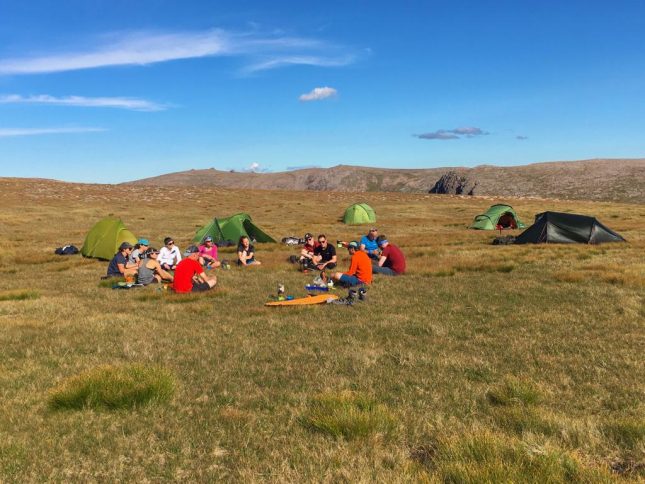Wild Camping
Wild camping can be a great experience and is an amazing way to spend time in nature. Whether you’re choosing to camp for the experience in its own right or as part of a journey through more remote locations, wild camping requires thought and care. To help you prepare to do this responsibly and efficiently, we asked Instructor Fi Chappell some questions about the topic.
How do you plan for an overnight trip in the hills?
Planning to stay out overnight in the hills could be for a variety of reasons. The objective could be walking to a camp spot to set up your tent in a remote space, enjoy the experience and walk out the next day. Or it could be part of a trip to reach some of the more remote areas and climb the hills that are not so easily accessible in a day and include a couple of nights or more of camping.
The kit for one night of wild camping or more is much the same. However if carrying it further then the weight of the kit becomes more important. The number of people sharing the carrying of the load may also influence the choice of equipment.
Weather forecasts will form a major part of the planning not just for the immediate days but also looking ahead. This can give an idea if deteriorating weather is anticipated that could arrive earlier than expected. Sometimes it may be possible to check online from campsites but being prepared for this not to be available can help avoid any unexpected surprises.
How to choose a tent?
It should suit the weather; on a calm and settled forecast, a lightweight two or three-season tent may be adequate. Though in Scotland, strong wind and heavy rain occur at any time of year, so sometimes a robust four-season tent is best. Tents come in various shapes, sizes and budgets so thinking about where and when you’ll use it to figure out what might be most appropriate.
I have a lightweight two-person tent for calm and dry overnight trips when I expect to be covering more distance. But I will carry a heavier, more robust two person tent if the weather is going to be more challenging. The lightweight tent is really only big enough for me once I’ve pulled all my other kit inside. The heavier tent comfortably takes two people (who cans share the weight) with space to keep wet kit in the porch area.
If camping in midge season, especially July and August, on calm and humid days then a tent with a decent midge barrier is essential as is having a midge net and repellent.
Other key pieces of equipment?
Next then is all the things to do with eating. My stove, gas, lighter, mug, spoon, and a 2-litre collapsible water pouch and plenty of food. I favour a gas stove that screws onto the gas cylinder with the container above for heating water. This means I can heat boil in the bag meals and have water boiled for dehydrated food and hot drinks. The 2-litre water pouch is carried empty and big enough that I can fill up from a nearby water source and don’t need to keep getting out of my tent to refill. Sometimes I carry a small water filter too and I’ll have my usual water bottle for liquid during the day.
Getting a good night’s sleep is very important; I’ll aim to find flat ground to pitch the tent on that isn’t stony, and either an inflatable mat or a foam mat will be my bed. If taking an inflatable mat, it’s worth taking a repair kit just in case of punctures. Next is a sleeping bag appropriate to the weather conditions and temperature. You can add a sleeping bag liner for extra warmth too.
Some basic toiletries include a toothbrush, toothpaste, soap, hand sanitizer, toilet roll, dog poo bags and a lightweight plastic trowel.
I also bring a small power pack for recharging my phone for reading and music, headphones, and my headtorch.

How do you prevent burning the ground when you cook?
Choosing where to cook is especially important when the ground is dry. Flat rocks that the stove can sit on comfortably or a gravelly section alongside a stream work well. If using rocks to shelter your stove from the wind then you should return them to their original places. The type of stove used will determine how near to the ground the flame is, as long, dry grass could catch light.
How to manage your waste?
The ethos of Leave No Trace is key to wild camping responsibly. You need to carry all rubbish out with you including fruit peel or cores, leftover food, teabags, and packaging. Sometimes you can minimise what needs to be carried out by leaving some of the packaging at home. Having a spare bag to tie up any waste is essential. Some of the bags that dehydrated meals come in are resealable so once you’ve eaten the food, it can be used for this purpose.
For human waste, use a trowel to dig a small hole 15cm deep and at least 30metres away from any water, paths or buildings. The hole with the poo in it should then be covered over and any toilet roll bagged and carried out. Another option is to have a poo tube where the poo is bagged and carried out in a sealed container. This may be appropriate in areas that are popular overnight camp sites, and requires consideration for when and where to dispose of the waste. For urinating, being well away from any water sources and downstream and well away from camp is important.
Care should also be taken to consider hygiene so hand washing and using hand sanitizer is important.
What to do about bad weather?
In bad weather pitching a tent can be decidedly troublesome. Avoid the challenges of this by organising in advance so the tent is readily accessible in your rucksack. Having the section that pitches first to hand, along with the poles and pegs is key. Tents that pitch outer first can make it easier to keep everything dry in the rain, and when you’re packing it away. If the inner pitches first, then being able to pitch the tent efficiently will speed up the process. For all types, it’s worth a trial run before heading out to see what works best!
When it’s windy, a team effort can be best when it comes to pitching the tent. It’s also worth thinking about what direction the wind is blowing and if it’s to change during the night. Pitching the tent with the entrance away from the wind will give some shelter. Also think about the shape of the tent and how the wind will blow around it, to avoid it being broadside on into the wind. Guy lines should be secure and it’s worth checking if they have worked loose or come undone during the night.
Other handy hints and tips
Make sure you’re familiar with the access rights in the area you’re exploring. Wild camping in here Scotland? Check out the Scottish Outdoor Access Code and it’s guidance on camping.
With an inflatable sleeping mat, always take a repair kit.
Check that your gas stove and gas cylinder are compatible before heading out on the hills, and bring a lighter. Some stoves have igniters but it’s worth having a back up.
Check that all the necessary poles, tent pegs, and guy lines are packed before heading out.
Have a couple of extra tent pegs, spare guy lines, and pole repair kit appropriate to the tent.
If the tent is packed in a heavy bag, swap for lightweight dry bags maybe splitting the inner and the outer.
About Fi

I am a Summer, Winter, and International Mountain Leader and Rock Climbing Instructor. When I’m not working in the hills, then most likely I am out playing in them, especially in winter; skiing, climbing, walking, and just having adventures!
Feeling inspired to get out and enjoy the hills?
Discover a whole new world of possibilities in the mountains on our Cairngorms Wild Camping course.
Our Hill & Mountain Skills course provides you with the skills to competently and independently explore the UK’s amazing hill & mountain environments, and an opportunity to build your confidence as you learn from our expert Instructors
Discover Navigation is a fantastic one day course that requires no previous experience, and gives you a solid foundational understanding of key navigational skills.
If you’re looking to brush up on or consolidate your navigation skills, our Further Navigation course allows you to develop your knowledge and understanding.